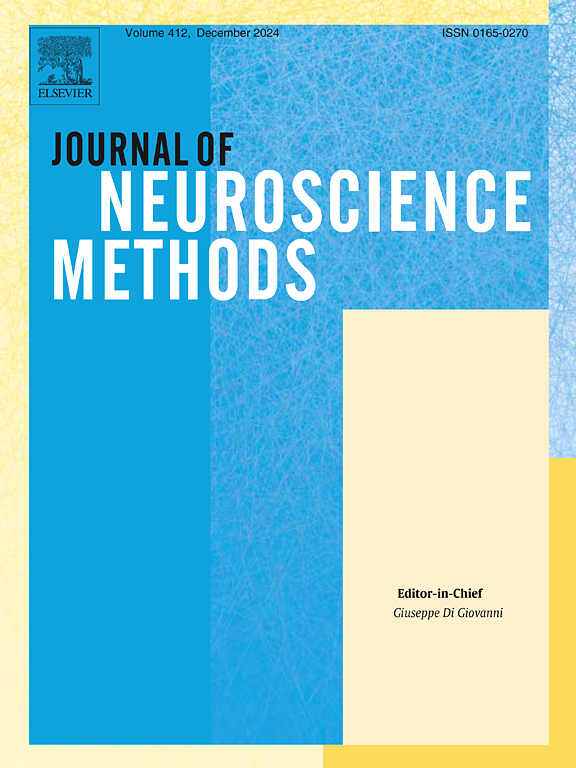基于脑电图的多频段多频空间特征融合情感识别方法。
IF 2.7
4区 医学
Q2 BIOCHEMICAL RESEARCH METHODS
引用次数: 0
摘要
背景:情绪变化的识别对一个人的身心健康具有重要意义。目前,基于脑电图的情绪识别方法主要集中在时域或频域,很少涉及空间信息。因此,本研究的目标是通过在多频段下整合频率和空间域信息来提高情绪识别的性能。新方法:首先提取四个频段的脑电信号,然后分别计算微分熵(DE)、对称差(SD)和对称商(SQ)三个频率空间特征;其次,根据脑电电极的分布,利用三个频率空间特征对每个频带构造一系列脑图;第三,利用构建的脑图进行多并行输入卷积神经网络(MPICNN)训练,得到情绪识别模型。最后,在DEAP和SEED-IV数据集上进行受试者相关实验。结果:DEAP数据集的实验结果表明,高价高唤醒、高价低唤醒、低价高唤醒和低价低唤醒四类情绪识别的平均正确率达到98.71%。SEED-IV数据集的结果显示,快乐、悲伤、中性和恐惧四类情绪识别的平均准确率达到92.55%。与现有方法的比较:在四类情绪识别数据集上,与现有方法相比,该方法具有最好的分类性能。结论:基于脑电图的情感识别方法在多频带下融合了多频空间特征,与现有方法相比,有效提高了识别性能。本文章由计算机程序翻译,如有差异,请以英文原文为准。
An EEG-based emotion recognition method by fusing multi-frequency-spatial features under multi-frequency bands
Background
Recognition of emotion changes is of great significance to a person’s physical and mental health. At present, EEG-based emotion recognition methods are mainly focused on time or frequency domains, but rarely on spatial information. Therefore, the goal of this study is to improve the performance of emotion recognition by integrating frequency and spatial domain information under multi-frequency bands.
New methods
Firstly, EEG signals of four frequency bands are extracted, and then three frequency-spatial features of differential entropy (DE) symmetric difference (SD) and symmetric quotient (SQ) are separately calculated. Secondly, according to the distribution of EEG electrodes, a series of brain maps are constructed by three frequency-spatial features for each frequency band. Thirdly, a Multi-Parallel-Input Convolutional Neural Network (MPICNN) uses the constructed brain maps to train and obtain the emotion recognition model. Finally, the subject-dependent experiments are conducted on DEAP and SEED-IV datasets.
Results
The experimental results of DEAP dataset show that the average accuracy of four-class emotion recognition, namely, high-valence high-arousal, high-valence low-arousal, low-valence high-arousal and low-valence low-arousal, reaches 98.71 %. The results of SEED-IV dataset show the average accuracy of four-class emotion recognition, namely, happy, sad, neutral and fear reaches 92.55 %.
Comparison with existing methods
This method has a best classification performance compared with the state-of-the-art methods on both four-class emotion recognition datasets.
Conclusions
This EEG-based emotion recognition method fused multi-frequency-spatial features under multi-frequency bands, and effectively improved the recognition performance compared with the existing methods.
求助全文
通过发布文献求助,成功后即可免费获取论文全文。
去求助
来源期刊

Journal of Neuroscience Methods
医学-神经科学
CiteScore
7.10
自引率
3.30%
发文量
226
审稿时长
52 days
期刊介绍:
The Journal of Neuroscience Methods publishes papers that describe new methods that are specifically for neuroscience research conducted in invertebrates, vertebrates or in man. Major methodological improvements or important refinements of established neuroscience methods are also considered for publication. The Journal''s Scope includes all aspects of contemporary neuroscience research, including anatomical, behavioural, biochemical, cellular, computational, molecular, invasive and non-invasive imaging, optogenetic, and physiological research investigations.
 求助内容:
求助内容: 应助结果提醒方式:
应助结果提醒方式:


